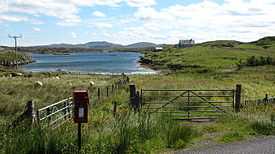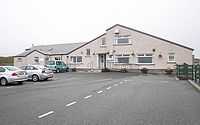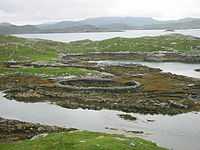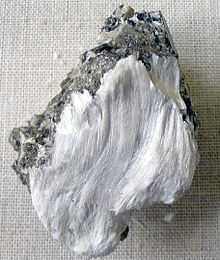Great Bernera
| Great Bernera | |
|---|---|
| Location | |
 Great Bernera | |
| OS grid reference | NB162344 |
| Names | |
| Gaelic name |
|
| Norse name | bjarnar-øy |
| Meaning of name | Bjørn's island from Norse[1] |
| Area and summit | |
| Area | 2122 ha |
| Area rank | 34[2] |
| Highest elevation | 87 metres (285 ft) |
| Population | |
| Population | 252[3] |
| Population rank | 29[2] |
| Pop. density | 11.9 people/km2[3][4] |
| Main settlement | Breaclete |
| Groupings | |
| Island group | Lewis and Harris |
| Local Authority | Na h-Eileanan Siar |
| References | [4][5] |
Great Bernera (Scottish Gaelic: Beàrnaraigh Mòr, pronounced [ˈpjaːrˠn̪ˠəɾaj moːɾ]), often known just as Bernera (Scottish Gaelic: Beàrnaraigh) is an island and community in the Outer Hebrides of Scotland. With an area of just over 21 km2 (8.1 sq mi), it is the thirty-fourth largest Scottish island.[4]
Great Bernera lies in Loch Roag on the north-west coast of Lewis and is linked to it by a road bridge. Built in 1953, the bridge was the first pre-stressed concrete bridge in Europe.[4][6] The main settlement on the island is Breaclete (Gaelic: Breacleit).
The island, under the name of "Borva", was the setting for A Princess of Thule (1873) by the Scottish novelist William Black. The novel is notable for its descriptions of the local scenery.
History

The island's name is Norse in origin[4] as are many other names in the district, implying extensive Norse settlement.
The most common name on Great Bernera is MacDonald (MacDhòmhnaill or Dòmhnallach), and these are said to be descended from a watchman of the Macaulays of Uig, who gave him the island in return for his services.[4]
Since 1962, the island has been owned by Robin de la Lanne-Mirrlees,[4] a former Queen's Herald, who is recognised as Laird of Bernera. He has a house and fish farm at Kirkibost.[4]
Calanais VIII
Callanish VIII is a unique standing stone arrangement near the bridge between Lewis and Bernera, set out in a semicircle. It is known locally as Tursachan, which means merely "Standing Stones".[7] The ruins of Dun Barraglom broch are nearby.[5]
Bostadh
Bernera is also known for its Iron Age (or possibly Pictish) settlement at Bostadh, discovered in 1992 and now covered by sand to preserve it. A replica Iron Age house matching those now buried is sited nearby.
Bernera Riot
The island was the location of the Bernera Riot, where crofters resisted the Highland clearances. The riot took place in 1874, and occurred as a reaction to heavy-handed evictions and treatment by the factor of Sir James Matheson, Donald Munro. The islanders refused to agree to an ever increasing diminishing grazings allowance at the expense of expanding sporting estates and were in turn threatened with a military visit. This did not occur, but even more eviction notices were handed out, and the visitors were pelted with clods of earth.[8]

Geography and geology
The island is roughly 8 km long by 3 km wide, the length being oriented from north west to south east. The coast is much indented and there are also numerous fresh water bodies such as Loch Barabhat, Loch Breacleit and Loch Niosabhat. The highest point is the eminence of Middle Shalaval south of Bostadh and north of Tobson that reaches 87 metres (285 ft).[5] There are deposits of muscovite and tremolite asbestos. An example of a rock of tremolite on muscovite from Great Bernera is shown in the photograph to the right.
The western side of the island is included in the South Lewis, Harris and North Uist National Scenic Area.[9]
Surrounding Islands
There are many islands in Loch Roag. to the west, from north to south are Pabaigh Mòr, Vacsay (Bhacsaigh), Fuaigh Mòr (Vuia Mòr), and Fuaigh Beag (Vuia Beg). To the north, the island of Bearnaraigh Beag (Little Bernera), and a number of islets. To the east, there are not so many islands, but there is Eilean Chearstaidh (Eilean Kerstay) to the south east.
Flora and fauna

Sea life is especially rich where there is tidal run between the Caolas Bhalasaigh (English: "Valasay Straits/Kyles") and the inner sea-loch of Tòb Bhalasaigh. There are numerous molluscs, sponges, brittlestars, and sea stars, the latter growing noticeably larger in size than normal. Cup Coral, Snakelocks Anemone and Dead Man's Fingers coral, may also be found here. Common fish include Shanny and Butterfish and Atlantic and Common Seals are regular off-shore visitors.[10]
Great Bernera hosts numerous sea bird species, including gulls, waders and ducks such as Goldeneye. More unusually, a Jack Snipe was observed on the island in 2007.[11]
Economy and infrastructure


Great Bernera's population is mainly dependent on lobster fishing, crofting and tourism. There is a Primary school located in Breacleit. Fertile machair pasture permits sheep and cattle grazing.[8] A processing plant was built at Kirkibost in 1972.[4] There are still some weavers but this is no longer one of the main industries. Breacleit is home to a small museum, mini-mart & off licence, school, a post office, church, community centre with café, petrol station, fire station and doctor's surgery.
Communications were much improved during the 20th century. The first telephone was installed on Lewis in 1897 and outlying villages were slowly connected. Great Bernera was the last exchange to link to Lewis with a single wire circuit and an earth return.[12] The bridge to the island from Lewis was built in 1953. It is said to be the first one of pre-stressed concrete in Europe. It was constructed after the islanders threatened to dynamite the hillside to create a causeway of their own making.[4]
In 2003 the island residents were considering a feasibility study into bringing the island into community ownership, a process that has been successfully completed by the islanders of Gigha and Eigg. However, the laird is apparently popular locally and has said he is unwilling to sell.[4][13] At the time of the 2011 census there were 252 people usually resident on the island,[3] an increase of 8% on the figure of 233 for 2001.[14]
Notable residents and visitors
- The former Chancellor of the Exchequer, Alistair Darling owns a converted blackhouse at Breaclete, and his mother's family were from the island[15]
- Callum Macdonald, arguably the most important publisher of Scottish poetry of the 20th century, who was born on the island.[16]
- Robin de la Lanne-Mirrlees who was the owner of Great Bernera
- Birthplace of Captain Murdo Stewart MacDonald (1852–1938) the last Sea Baron and Lloyd Surveyor of Shipping
References
- ↑ Mac an Tàilleir, Iain (2003) Ainmean-àite/Placenames. (pdf) Pàrlamaid na h-Alba. Retrieved 26 August 2012.
- ↑ 2.0 2.1 Area and population ranks: there are c. 300 islands >20ha in extent and 93 permanently inhabited islands were listed in the 2011 census.
- ↑ 3.0 3.1 3.2 National Records of Scotland (15 August 2013) (pdf) Statistical Bulletin: 2011 Census: First Results on Population and Household Estimates for Scotland - Release 1C (Part Two). "Appendix 2: Population and households on Scotland’s inhabited islands". Retrieved 17 August 2013.
- ↑ 4.0 4.1 4.2 4.3 4.4 4.5 4.6 4.7 4.8 4.9 4.10 Haswell-Smith, Hamish (2004). The Scottish Islands. Edinburgh: Canongate. pp. pp. 287–301. ISBN 978-1-84195-454-7.
- ↑ 5.0 5.1 5.2 Ordnance Survey. Get-a-map (Map). 1:25,000. Leisure. http://www.ordnancesurvey.co.uk/oswebsite/getamap/. Retrieved 21 August 2013.
- ↑ "Details of the construction and opening of the bridge". Retrieved 21 September 2009.
- ↑ "Great Bernera, 'Tursachan', Barraglom". RCAHMS. Retrieved 2008-06-22.
- ↑ 8.0 8.1 Keay, J. & Keay, J. (1994). Collins Encyclopaedia of Scotland. London: HarperCollins.
- ↑ "South Lewis, Harris and North Uist" (pdf). SNH. Retrieved 2008-06-26.
- ↑ The Outer Hebrides Handbook and Guide. Kittiwake. 1995. pp. 97–102.
- ↑ "Bird Sightings : Hebrides : December 2007". thewesternisles.co.uk. Retrieved 2008-06-20.
- ↑ Thompson, Francis (1968). Harris and Lewis. Newton Abbott: David and Charles. p. 84.
- ↑ "Newsletter". Scottish Islands Network. March 2003. Retrieved 2008-06-21.
- ↑ General Register Office for Scotland (28 November 2003) Scotland's Census 2001 – Occasional Paper No 10: Statistics for Inhabited Islands. Retrieved 26 February 2012.
- ↑ Angus Howarth (2004-03-20). "Darling hit with holiday home tax". The Scotsman. Retrieved 2007-03-22.
- ↑ Calder, Angus (4 March 1999). "Obituary: Callum Macdonald". The Independent (London). Retrieved 2008-07-07.
External links
| Wikivoyage has a travel guide for Great Bernera. |
| |||||
| ||||||||||
| ||||||||||||||||||||||||||||||||||||||||||||||||||||||||||||||||||||||||||||||||||||||||||||||||||||||||||||||||||||||||||||||||||||||||||||||||||||||||||||||||
Coordinates: 58°13′48″N 6°51′0″W / 58.23000°N 6.85000°W


